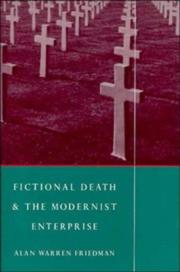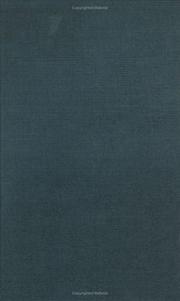| Listing 1 - 10 of 11 | << page >> |
Sort by
|
Book
ISBN: 3846756059 Year: 2013 Publisher: München : Wilhelm Fink,
Abstract | Keywords | Export | Availability | Bookmark
 Loading...
Loading...Choose an application
- Reference Manager
- EndNote
- RefWorks (Direct export to RefWorks)
How does thought become manifest in works of art? How do literature and the arts influence and enrich our knowledge of death and creativity? This essay presents a new and fascinating method for cross-cultural and interdisciplinary studies in the humanities. According to Kant’s Critique of Judgement, literature and art have worked, from the beginning, towards not only expanding but also transcending the realm of common experience. They strive to represent the unrepresentable, speak of the ineffabile and advance into areas beyond all rational analysis, beyond the limits at which all attempts at philosophical or scientific explanations fail. Proceeding from the assumption that a history of cultural knowledge is not congruent with a history of abstract concepts or rational ideas, this essay presents a new and fascinating cross-cultural and interdisciplinary approach for analysing the powers of literature and art to form aesthetic ideas of lasting cultural impact, for analysing the interrelation between the formative forces of the imagination and the form-giving material or medium. Its focus is on Figurations of the Creative and Figurations of Death. Both of these topics raise questions relevant to all cultures: how does innovation enter the world; how does a society come to terms with the deepest and most basic uncertainty of human existence, the awareness of mortality? For on this depends any assignment of meaning to earthly existence, as does any notion of worldly or otherworldly salvation.
Creation (Literary, artistic, etc.) --- Mortality in literature. --- Mortality --- Aesthetics. --- Philosophy.
Book
ISBN: 1280688130 9786613665072 9004229027 9789004229020 9789004222090 900422209X Year: 2012 Publisher: Boston : Brill,
Abstract | Keywords | Export | Availability | Bookmark
 Loading...
Loading...Choose an application
- Reference Manager
- EndNote
- RefWorks (Direct export to RefWorks)
This book focuses on the representation of human mortality in early medieval Chinese literature. This theme is observed and reconstructed through the contextual and intertextual analysis of the work of eminent writers of the period, texts that have never been examined from an eschatological perspective. Through this perspective, and the careful use of research from the fields of religion and anthropology, the book offers a fresh view of commentator Wang Yi (fl. 89–158), well-known poets Ruan Ji (210–63), Tao Qian (365?–427), and Xie Lingyun (385–433), and also brings into the discussion relevant works by several previously neglected authors. The book contributes a new angle from which to appreciate literature of this and other periods in Chinese history.
Chinese poetry --- Mortality in literature. --- Death in literature. --- LITERARY CRITICISM / Asian / General --- History and criticism.
Book
ISBN: 0824869672 0824838416 Year: 2014 Publisher: Honolulu : University of Hawaii Press,
Abstract | Keywords | Export | Availability | Bookmark
 Loading...
Loading...Choose an application
- Reference Manager
- EndNote
- RefWorks (Direct export to RefWorks)
When he died from tuberculosis at the age of thirty-one, Kajii Motojirō had written only twenty short stories. Yet his life and work, it is argued here, sheds light on a significant moment in Japanese history and, ultimately, adds to our understanding of how modern Japanese identity developed. By the time Kajii began to write in the mid-1920s there was heated debate among his peers over "legitimate" forms of literary expression: Japanese Romantics questioned the value of a western-inspired version of modernity; others were influenced by Marxist proletarian literature or modernist experimentation; still others tried to create a distinctly Japanese fictional style that concentrated on first-person perspective, the so-called "I-novel." There was a general sense that Japan needed to reinvent itself, but writers and artists were at odds over what form this reinvention should take. Throughout his career, Kajii drew from these various camps but belonged to none of them, making his work an invaluable indicator of a culture in crisis and transition. The Youth of Things is the first full-length book devoted to Kajii Motojirō. It brings together English translations of nearly all his completed stories with an analysis of his literature in the context of several major themes that locate him in 1920s Japan. In particular, Dodd links the writer's work with the physical body: Kajii's subjective literary presence was grounded first and foremost in his TB-stricken physical body, hence one cannot be studied without the other. His concerns with health and mortality drove him to play a central role in constructing a language for modern literature and to offer new insights into ideas that intrigued so many other Taishō intellectuals and writers. In addition, Kajii's early years as a writer were strongly influenced by the cosmopolitan humanism of the White Birch (Shirakaba) school, but by the time his final work was published in the early 1930s, an environment of greater cultural introspection was beginning to take root, encapsulated in the expression "return to Japan" (nihon kaiki). Only a few years separate these two moments in time, but they represent a profound shift in the aspirations and expectations of a whole generation of writers. Through a study of Kajii's writing, this book offers some sense of the demise of one cultural moment and the creation of another.
Death in literature. --- Mortality in literature. --- Kajii, Motojirō, --- Criticism and interpretation.
Book
ISBN: 1108843395 1108918565 1108911021 1108910424 Year: 2023 Publisher: Cambridge ; New York, NY : Cambridge University Press,
Abstract | Keywords | Export | Availability | Bookmark
 Loading...
Loading...Choose an application
- Reference Manager
- EndNote
- RefWorks (Direct export to RefWorks)
Drawing together leading scholars of early modern memory studies and death studies, Memory and Mortality in Renaissance England explores and illuminates the interrelationships of these categories of Renaissance knowing and doing, theory and praxis. The collection features an extended Introduction that establishes the rich vein connecting these two fields of study and investigation. Thereafter, the collection is arranged into three subsections, 'The Arts of Remembering Death', 'Grounding the Remembrance of the Dead', and 'The Ends of Commemoration', where contributors analyse how memory and mortality intersected in writings, devotional practice, and visual culture. The book will appeal to scholars of early modern literature and culture, book history, art history, and the history of mnemonics and thanatology, and will prove an indispensable guide for researchers, instructors, and students alike.
Mortality in literature. --- Death in literature. --- Memory in literature. --- Memory as a theme in literature --- English literature --- History and criticism.

ISBN: 0521442613 Year: 1995 Publisher: Cambridge Cambridge University Press
Abstract | Keywords | Export | Availability | Bookmark
 Loading...
Loading...Choose an application
- Reference Manager
- EndNote
- RefWorks (Direct export to RefWorks)
Book
ISBN: 9789044125634 Year: 2009 Volume: 23 Publisher: Antwerpen Garant
Abstract | Keywords | Export | Availability | Bookmark
 Loading...
Loading...Choose an application
- Reference Manager
- EndNote
- RefWorks (Direct export to RefWorks)
Philosophy and psychology of culture --- Literature --- Death in literature. --- Mortality in literature. --- Literature, Modern --- Philosophy. --- History and criticism. --- literatuurwetenschap --- literatuur --- filosofie --- 82:1 --- Literatuur en filosofie --- 82:1 Literatuur en filosofie --- Death in literature --- Mortality in literature --- Literature and philosophy --- Philosophy and literature --- History and criticism --- Philosophy --- Theory
Book
ISBN: 9789004222090 Year: 2012 Publisher: Leiden [etc.] Brill
Abstract | Keywords | Export | Availability | Bookmark
 Loading...
Loading...Choose an application
- Reference Manager
- EndNote
- RefWorks (Direct export to RefWorks)
Chinese poetry --- Death in literature --- Mortality in literature --- S13A/0410 --- S16/0195 --- S16/0200 --- History and criticism --- China: Religion--Death, funeral, ancestral worship --- China: Literature and theatrical art--Thematic studies --- China: Literature and theatrical art--Traditional poetry and poets: studies
Book
ISBN: 1472542932 1282453017 1441165436 9781441165435 9780826498359 0826498353 9781441160003 1441160000 9781441191311 1441191313 9781472542939 9781282453012 Year: 2009 Publisher: London New York Continuum
Abstract | Keywords | Export | Availability | Bookmark
 Loading...
Loading...Choose an application
- Reference Manager
- EndNote
- RefWorks (Direct export to RefWorks)
"Death is indisputably central to Beckett's writing and reception. This collection of research considers a number of Beckett's poems, novels, plays and short stories through considerations of mortality and death. Chapters explore the theme of deathliness in relation to Beckett's work as a whole, through three main approaches. The first of these situates Beckett's thinking about death in his own writing and reading processes, particularly with respect to manuscript drafts and letters. The second on the death of the subject in Beckett links dominant 'poststructural' readings of Beckett's writing to the textual challenge exemplified by the The Unnamable. A final approach explores psychology and death, with emphasis on deathly states like catatonia and Cotard's Syndrome that recur in Beckett's work. Beckett and Death offers a range of cutting-edge approaches to the trope of mortality, and a unique insight into the relationship of this theme to all aspects of Beckett's literature."--Bloomsbury Publishing.
Death in literature. --- Mortality in literature. --- Beckett, Samuel, --- Beckett, Samuel --- Pei-kʻo-tʻe, Sa-miao-erh, --- Beḳeṭ, Samuel, --- Beckett, Sam, --- Беккет, Сэмюэль, --- בעקעט, סאמועל --- בקט, סמואל --- בקט, סמואל, --- بكت، ساموئل --- Bikit, Sāmūʼil, --- Criticism and interpretation.

ISBN: 0198183860 0191674117 019818493X 0191588563 Year: 1997 Publisher: Oxford ; New York ; Athens Clarendon Press
Abstract | Keywords | Export | Availability | Bookmark
 Loading...
Loading...Choose an application
- Reference Manager
- EndNote
- RefWorks (Direct export to RefWorks)
English literature --- Thematology --- Drama --- anno 1600-1699 --- Bereavement in literature --- Death in literature --- Dood in de literatuur --- Mort dans la littérature --- Sterfte in de literatuur --- Death in literature. --- Death --- English drama (Tragedy) --- English drama --- Identity (Philosophical concept) in literature. --- Mortality in literature. --- Renaissance --- Social aspects --- History --- History and criticism. --- History and criticism --- Early modern and Elizabethan, 1500-1600 --- 17th century
Book
ISBN: 1108395120 1108381499 1108397166 1108422330 Year: 2018 Publisher: Cambridge : Cambridge University Press,
Abstract | Keywords | Export | Availability | Bookmark
 Loading...
Loading...Choose an application
- Reference Manager
- EndNote
- RefWorks (Direct export to RefWorks)
Seventeenth-century England teemed with speculation on body and its relation to soul. Descartes' dualist certainty was countered by materialisms, whether mechanist or vitalist. The most important and distinctive literary reflection of this ferment is John Milton's vitalist or animist materialism, which underwrites the cosmic worlds of Paradise Lost. In a time of philosophical upheaval and innovation, Milton and an unusual collection of fascinating and diverse contemporary writers, including John Donne, Margaret Cavendish, John Bunyan, and Hester Pulter, addressed the potency of the body, now viewed not as a drag on the immaterial soul or a site of embarrassment but as an occasion for heroic striving and a vehicle of transcendence. This collection addresses embodiment in relation to the immortal longings of early modern writers, variously abetted by the new science, print culture, and the Copernican upheaval of the heavens.
Death. --- Mortality in literature. --- Death in literature. --- Death --- Dying --- End of life --- Life --- Terminal care --- Terminally ill --- Thanatology --- Philosophy --- Milton, John, --- Milṭan, Jān, --- Milʹton, Dzhon, --- Милтон, Джон, --- Miltūn, Zhūn, --- Miltonus, Joannes, --- J. M. --- M., J. --- Milʹton, Īoann, --- Milton, Gioanni, --- Milton, Giovanni, --- מילטאן, יאהאן --- מילטאן, יוחנן --- מילטון, ג׳והן --- מלטן, יוחנן --- Criticism and interpretation.
| Listing 1 - 10 of 11 | << page >> |
Sort by
|

 Search
Search Feedback
Feedback About
About Help
Help News
News